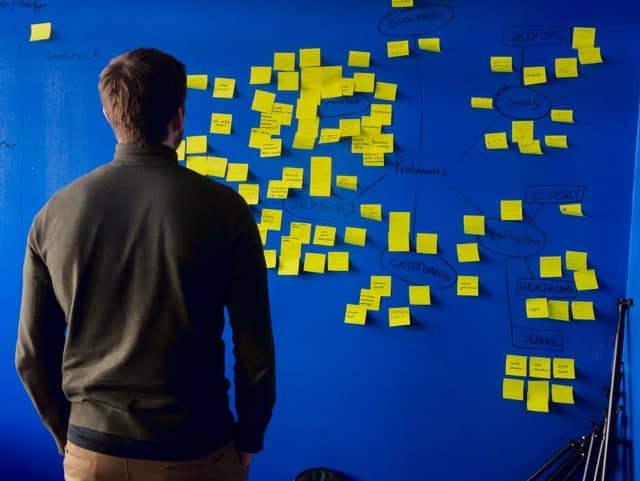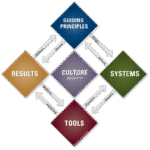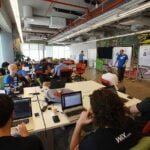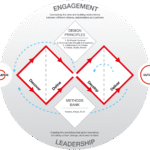If you have ever found yourself stuck in the search for ideas or solutions, you have probably turned to some form of brainstorming without even realizing it. But what exactly is brainstorming, and why is it such a powerful tool?
Growing competition, rapid technological advancements, and the dynamic environment in which organizations operate are increasing the challenges of problem-solving and decision-making (Seeber et al., 2017). In this context, today’s managers need tools that help them face these challenges effectively.
One such tool is brainstorming, as it facilitates teamwork and collaboration to find innovative solutions to a company’s problems.
Integrating brainstorming into your problem-solving process promotes collaboration and innovative thinking. However, it is also important to highlight that it should be combined with other tools for decision-making or the implementation of innovation processes.
What is Brainstorming?
“Brainstorming,” also known in Spanish as lluvia de ideas or tormenta de ideas, was first introduced in 1942 and popularized by Alex Faickney Osborn in his book Applied Imagination: Principles and Procedures of Creative Thinking, published in 1953 (Besant, 2016).
Brainstorming is defined as an idea-generation technique in which a group of people—or an individual—freely expresses all possible ideas related to a specific problem or topic without filtering them. This method aims to stimulate creativity and foster innovation without initial constraints. In this regard, Pick et al., (2024), using brainstorming sessions, report that group creativity is influenced by the interaction between two distinct types of group brain dynamics: a flexibility mindset and a herd behavior mindset.
Essentially, brainstorming leverages the collective intelligence of a group. By suspending judgment and embracing a wide range of ideas, participants can drive innovation and find solutions to complex problems.
Why is Brainstorming Important?
The use of brainstorming creates a free and open environment where everyone can participate, helping to reduce social inhibitions among group members to stimulate idea generation and enhance creativity.
Brainstorming is primarily used to:
- Encourage creativity: Allows ideas to flow freely without initial restrictions.
- Facilitate problem-solving: Helps find innovative solutions to complex challenges.
- Promote collaboration: Encourages teams to share different perspectives.
- Reduce fear of failure: Creates an environment where all ideas are welcomed.
- Improve decision-making: By exploring multiple options, brainstorming can lead to better-informed decisions.
Principles and Rules of Brainstorming
For a brainstorming session to be effective, it must follow these key principles:
- Generate as many ideas as possible: Creativity does not emerge instantly, and often the best ideas appear after an exploratory process.
- Avoid judging or criticizing ideas: Premature criticism blocks creativity and makes participants self-censor.
- Encourage creativity and the unexpected: The most innovative ideas are often the most unusual. There is no need to fear the strange or radical.
- Build on others’ ideas: Teamwork is key. Ideas should be combined and improved to arrive at stronger solutions.
Types of Brainstorming
Since its creation, the way brainstorming is executed has undergone various adaptations, which we describe below:
Directed Brainstorming
Directed brainstorming works when the problem-solving space (sets of criteria for evaluating ideas) is known before the session.
In directed brainstorming, each participant is given a piece of paper and told the brainstorming question. They are asked to write down an answer and stop. Then, all the papers are randomly exchanged among the participants.
Participants are asked to look at the idea they received and create a new idea that improves upon that idea based on the initial criteria. The process repeats for three or more rounds.
Nominal Group Technique
Participants are asked to write down their ideas anonymously. The facilitator then collects the ideas, and the group votes on each idea.
The selected list of ideas is presented to the group for another brainstorming session.
Pass-the-Paper Technique
Each person in the group receives a sheet of paper and writes down an idea; then they pass the sheet of paper to the next person, who adds some thoughts. This continues until everyone has their original sheet back.
Team Idea Mapping Method
This brainstorming method works by associating ideas. It can improve collaboration and increase the number of ideas.
The process begins with a well-defined topic. Each participant brainstorms individually, and then all the ideas are gathered into a large idea map.
During the consolidation phase, participants may discover common insights about the problems, as they share their thoughts behind their ideas.
Once all ideas are captured, the group can prioritize them.
Guided Brainstorming
A guided brainstorming session is a time reserved for exchanging ideas, either individually or as a collective group, on a specific topic within the limitations of perspective and time.
Guided brainstorming removes all causes of conflict and restricts conversations while stimulating critical and creative thinking.
Participants are asked to adopt different mindsets during a predefined time period while contributing their ideas to a central map.
Individual Brainstorming
Individual brainstorming is the use of the technique on an individual basis.
It typically includes techniques such as free writing, free speaking, word association, and creating a mind map.
Individual brainstorming is a useful method in creative writing.
Question Brainstorming
This method involves brainstorming about questions, rather than trying to find immediate answers and short-term solutions.
Gregersen (2018) highlights that brainstorming helps avoid group dynamics that often restrict opinions and allows reformulating problems in ways that stimulate innovative thinking.
The answers to the questions form the framework for building future action plans.
“Questorming” is another term for this technique.
Online Brainstorming
For this brainstorming technique, all you need is a central location for team members to write down their ideas.
Wilson (2022) recommends that if all team members are in the same time zone, the brainstorming session can be organized on an online app. However, if the team is distributed globally and thus in different time zones, the best option would be to develop a “Google Doc” document, allowing participants to write down their ideas whenever inspiration strikes.
Methods and Techniques of Brainstorming
There are various brainstorming techniques, each with different approaches depending on the type of problem or workgroup.
Classic Method
This traditional method involves a group of people generating ideas freely. A facilitator encourages participants to share their thoughts without criticism or judgment.
Brainwriting
In brainwriting, participants write their ideas individually and then share them with the group. This technique can be particularly useful for introverted individuals.
SCAMPER Technique
SCAMPER is a creative problem-solving tool that encourages participants to consider different ways to modify an existing product or process. The acronym stands for:
- Substitute: What can be substituted?
- Combine: What can be combined?
- Adapt: What can be adapted?
- Modify: What can be modified or expanded?
- Put to another use: What can be repurposed?
- Eliminate: What can be eliminated?
- Reverse: What can be reversed or reorganized?
Mind Mapping
Mind maps are a visual technique in which ideas are organized in a hierarchical structure. Participants start with a central idea and branch out into related concepts.
Reverse Brainstorming
Participants identify ways to make a problem worse and then look for solutions to reverse it.
Six Thinking Hats Technique
Each participant adopts a different thinking role (emotional, logical, creative, critical, etc.).
How to Organize a Brainstorming Session
If you are going to organize a brainstorming session, you need to consider two phases: preparation and execution.
Preparation Phase
Before conducting a brainstorming session, it is essential to:
- Determine the information or preparation the group needs.
- Establish basic rules.
- Identify key participants and their roles.
- Choose the session’s location.
- Be aware of common mistakes made during brainstorming workshops.
Basic Rules
Osborn (Jackson, ?) established four basic rules for a successful brainstorming session:
- Go for quantity: Encourage divergent thinking, as generating a large number of ideas increases the probability of finding an innovative solution.
- No criticism: Criticism should be avoided during the idea-generation phase. Instead, participants should focus on expanding and building upon ideas, leaving evaluation for a later stage.
- Welcome all ideas, even the “crazy” ones: New perspectives and assumptions should be explored. Innovative solutions often come from unconventional thinking.
- Combine and improve ideas: Encourage idea-building through association.
Participants and Roles
A crucial step is determining who will participate in the brainstorming session.
A brainstorming workshop with a high percentage of like-minded individuals may not generate as many creative ideas as a diverse group. It is essential to include people from various disciplines, backgrounds, and thinking styles.
Experts recommend groups of 5 to 8 participants.
A brainstorming session should have at least the following roles:
- Moderator: Leads the brainstorming session, explains the problem to be solved, facilitates the discussion, and clarifies doubts.
- Secretary: Records all the ideas generated during the session.
- Participants: As diverse in knowledge and experience as possible.
Choosing the Type of Brainstorming
During the preparation phase, you must also choose the type of brainstorming session to implement, depending on factors such as:
- Participants’ backgrounds and experience in brainstorming sessions.
- Team members’ locations (for instance, online brainstorming sessions may be an option).
- Available financial resources.
Execution Phase
A brainstorming session typically consists of four stages:
- Warm-up
- Idea generation (presenting the problem)
- Idea improvement (discussion)
- Evaluation (validation)
Warm-up
It is essential to conduct a proper warm-up exercise to break the ice among participants, especially if they are not used to working together or do not know each other.
Present the Problem
Clearly define the problem to be solved and establish the criteria to be met.
Give participants time to brainstorm in silence at the beginning of the session to generate as many ideas as possible. Then, ask them to share or present their ideas, ensuring that everyone has a fair chance to contribute.
In Table 01, we present some techniques you can use in your brainstorming session depending on the type of brainstorming you have organized.
Table 01. Techniques You Can Use in Your Brainstorming Session.
| Technique | Description | How It Is Used |
|---|---|---|
| Silent | Write ideas first, then share. | – Gives everyone the opportunity to think of ideas. – Helps when there are introverted participants. – Works best for teams strongly influenced by the first ideas presented. |
| Open | Call out ideas. | – Generates a large number of ideas quickly. – Allows for faster collaboration. – Favors extroverts. |
| Structured | Provides brainstorming topics (e.g., teams/tools, communications, procedures, environment, etc.). | – Generates a collection of ideas on a particular topic or issue. – Helps generate ideas to achieve a specific goal or theme. |
| Counteracting | Brainstorming on how to make things worse. | – Useful when it’s difficult to directly identify solutions to the problem. – Good for creative problem-solving and can lead to strong solutions. |
| Analogy | Relate a story to the problem at hand, using parallels. | – Helps generate solutions that might not have been considered otherwise. – Useful for uncovering insights about one’s own situation, allowing for solutions based on those discoveries. |
Source: Minnesota Department of Administration.
Guide the Discussion
Once all participants have shared their ideas, start a group discussion to develop and build on others’ ideas, using them to create new ones.
Building on others’ ideas is one of the most valuable aspects of brainstorming.
You should encourage everyone to contribute and develop ideas, including quieter participants, and prevent anyone from criticizing ideas.
Idea Evaluation (Validation)
Once you have gathered the ideas, prioritization and evaluation become necessary. This is the time to judge the ideas, determining which ones should be discarded and which are valuable.
The criteria for evaluation may include:
- Availability of resources
- Feasibility of execution
- Implementation timeframe
- Alignment with the company’s mission and vision
How to Improve Your Brainstorming Sessions
According to the Dynamic Consultation Manual, the success of a brainstorming session depends on its members recognizing the importance of creating a positive environment and avoiding negative judgments.
Additionally, Asana (2021) reports that all brainstorming techniques include the following three steps:
- Idea capture
- Idea analysis and critique
- Selection of ideas to implement
With this in mind, you should consider these three steps; however, to implement the ideas, you may need to use other tools such as design thinking or business model development.
There are several ways groups can improve the effectiveness and quality of their brainstorming sessions. Below are recommendations from Forsyth (2014):
- Avoid having groups face each other directly.
- Stick to the rules.
- Pay attention to everyone’s ideas.
- Include both individual and group approaches.
- Take breaks.
- Do not rush the sessions.
- Stay persistent.
- Facilitate the session.
Online Brainstorming Tools
In today’s digital world, several tools allow you to organize online brainstorming sessions. Below is a list of free-access brainstorming applications:
EdrawMind
EdrawMind is a free-access application available on various platforms such as Windows, Mac, iOS, Android, and Linux. There is also an online version of the tool.
MindMeister
Mindmeister is a collaborative idea-sharing tool based on mind maps.
The free version allows unlimited collaboration but limits users to three mind maps.
Key features of MindMeister include: real-time collaboration, a user interface based on mind maps, and three free mind maps.
Coggle
Coggle is another brainstorming tool based on mind maps. The free version allows collaboration and is perfect for occasional brainstorming sessions.
Key features include: a mind mapping tool, unlimited public diagrams, and real-time collaboration.
Popplet
The free version of Popplet is sufficient for personal brainstorming sessions.
Popplet is designed for students, educators, and businesses. It has a simple user interface with drag-and-drop controls.
Essentially, Popplet is a mind-mapping tool perfect for individuals who prefer maps over other methods.
Stormboard
Stormboard is an online brainstorming software. In its free version, it serves as an idea-sharing tool for individuals and small teams.
You can access Stormboard from any browser. It features an infinite canvas for a single session and includes various templates to choose from.
Mindly
Mindly is a mobile application that helps users capture and organize their ideas, as well as conduct individual brainstorming sessions.
If you are a visual thinker, Mindly is the perfect tool for you, as it eliminates unnecessary clutter and helps you focus on your ideas, thoughts, and concepts. You can export your ideas as a mind map in PDF format.
How to Choose the Best Brainstorming Method?
Each situation requires a different strategy:
| Type of Problem | Recommended Method |
|---|---|
| Product Innovation | SCAMPER, Mind Maps |
| Complex Problem Solving | Reverse Brainstorming, Six Hats |
| Rapid Idea Generation | Brainwriting, Classic Method |
Common Brainstorming Mistakes and How to Avoid Them
- Lack of Structure → Solution: Define time limits and objectives.
- Fear of Sharing Ideas → Solution: Create a trustful environment.
- Low Participation → Solution: Try brainwriting to include everyone.
Brainstorming in Design Thinking
Brainstorming alone is not enough to create value in an organization; it is merely an initial step in the collaborative idea development process and does not produce a final solution (Seeber et al 2017). Therefore, this tool must be complemented with other methods.
Brainstorming can be used in the ideation phase of the design thinking process. In this sense, idea generation is the first step in a design thinking approach.
Through brainstorming, participants can explore a wide range of approaches instead of relying solely on conventional methods.
Brainstorming and Artificial Intelligence
Grüning and Rowland (2024) highlight that artificial intelligence (AI) can be a useful tool for enhancing the brainstorming process, overcoming social barriers to creative collaboration, and facilitating scenario planning.
In this regard, Memmert and Tavanapour (2023) explored the collaboration between humans and generative AI in a brainstorming setting, examining how individuals perceive working with a generative AI system (GPT-3). They concluded that generative AI has the potential to improve brainstorming, but careful design is needed to maximize benefits and mitigate potential drawbacks.
Similarly, Muller et al., (2024) concluded that humans and AI can effectively collaborate to propose and refine ideas in online brainstorming sessions, accelerating decision-making.
Conclusion
Brainstorming is an ideal tool for creativity, idea generation, and promoting collaborative teamwork within a company. However, it should be complemented with other techniques for decision-making and innovation process implementation.
There are several types of brainstorming sessions, and choosing the right type depends on the team you are working with and the session’s objectives.
Undoubtedly, brainstorming can assist in creative processes and problem-solving for your products or services. However, you should train yourself to implement successful brainstorming sessions.
References
Asana. 2021. Brainstorming: las mejores técnicas de lluvia de ideas para estimular la creatividad.
Besant Hanisha. 2016. The Journey of Brainstorming. Journal of Transformative Innovation, Issue: 1, Volume: 2
Forsyth, Donelson (2014). Group Dynamics 6th Edition. Belmont, California: Wadsworth Engage Learning. ISBN 9781133956532.
Gregersen Hal. 2018. Better Brainstorming: Focus on questions, not answers, for breakthrough insights. Harvard Business Review.
Grüning, D. J., & Rowland, N. (2024). Brainstorming and Artificial Intelligence. Available at SSRN 4795561.
Herramientas para la creatividad. Manual dinámico de consulta (vol. 2). 49 p.
Jackson Jennifer. How to brainstorm: 4 ways to get the creative juices flowing. Lucidchart.
Memmert, L., & Tavanapour, N. (2023). Towards human-AI-collaboration in brainstorming: Empirical insights into the perception of working with a generative AI. ECIS 2023 Research Papers.
Mind Tools. Brainstorming: Generating Many Radical, Creative Ideas.
Minnesota Department of Administration. Brainstorming Techniques. 4 p.
Muller, M., Houde, S., Gonzalez, G., Brimijoin, K., Ross, S. I., Moran, D. A. S., & Weisz, J. D. (2024, June). Group Brainstorming with an AI Agent: Creating and Selecting Ideas. In International Conference on Computational Creativity.
Pick, H., Fahoum, N., Zoabi, D., & Shamay Tsoory, S. G. (2024). Brainstorming: Interbrain coupling in groups forms the basis of group creativity. Communications Biology, 7(1), 1-10. https://doi.org/10.1038/s42003-024-06614-7
Seeber Isabella, Gert-Jan de Vreede, Ronald Maier & Barbara Weber (2017) Beyond Brainstorming: Exploring Convergence in Teams, Journal of Management Information Systems, 34:4, 939-969, DOI: 10.1080/07421222.2017.1393303
Wikipedia. Brainstorming.
Wilson J. 2022. 10 effective brainstorming techniques for teams. Wework Ideas.
Editor and founder of “Innovar o Morir” (‘Innovate or Die’). Milthon holds a Master’s degree in Science and Innovation Management from the Polytechnic University of Valencia, with postgraduate diplomas in Business Innovation (UPV) and Market-Oriented Innovation Management (UPCH-Universitat Leipzig). He has practical experience in innovation management, having led the Fisheries Innovation Unit of the National Program for Innovation in Fisheries and Aquaculture (PNIPA) and worked as a consultant on open innovation diagnostics and technology watch. He firmly believes in the power of innovation and creativity as drivers of change and development.






